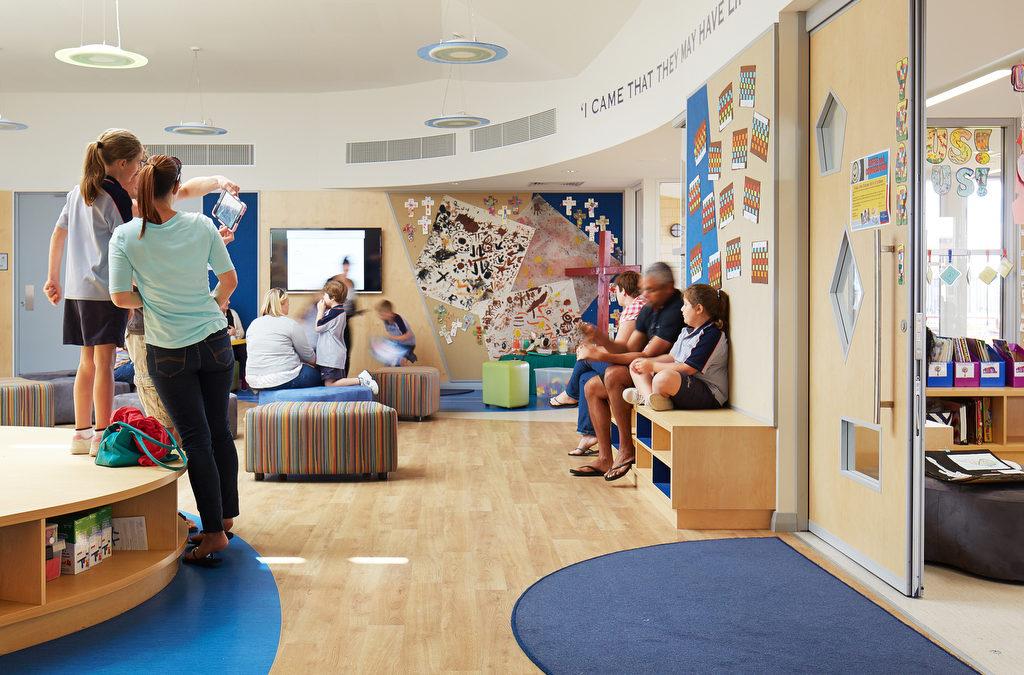John Dewey believed that children learn best by doing, a concept extended in the Reggio Emilia and Montessori approaches, both of which recognize the role of the physical environment in shaping how young children acquire knowledge.
To create preschools and kindergartens in which the physical environment is closely integrated with pedagogy and assists both teaching and learning, architects must consult educational theory and practices, study learning environments, and examine architectural precedents to understand which architectural features of schools best encourage children’s engagement and which are counterproductive.
Understanding how the physical environment influences and shapes learning requires a comprehensive approach to the programming, planning, and design of schools—an approach in which research plays an integral part. Research can inform the designer about the “transactional nature” of the learning environment—that is, how the physical environment affects the learner. Examples of such research include Barker and Gump (1964), Lippman (1997), and Kennedy and Moore (1998).
Before designers create a preschool or kindergarten, they must understand the social and emotional advancements that children are making during these years. In addition, they must understand how influential pedagogical theories—such as constructivist the-ory and practice theory (Lippman 2011)—describe the role of the physical environment in the learning process. Such understanding helps architects become informed and effec-tive advocates for design innovation.
Guidelines for the design of learning communities
This chapter provides guidelines for the design of 21st-century classrooms and entire learning communities. Grulke, Beert, and Lane (2001) propose the concepts of personal-ization and ability to manage interactions. Two more concepts—of flow (or transition) and of layered spaces of variable size—are recommended by Lippman (2011; 2004). A fifth concept, place attachment, is derived from Low and Altman (1992).
The concepts and guidelines described above suggest attributes of learning environ-ments that support the variety of ways in which people learn. While relevant to all learning environments, they are fundamental for planning and designing preschools and kindergartens.
Personalization and managing interactions
Personalization is required to create spaces in which all members of the learning com-munity are enabled, engaged, and empowered to acquire knowledge and master skills. The learning, social, and physical environments are understood as working together to encourage learning. In a personalized setting, teachers are encouraged to work coop-eratively with one another as they develop a curriculum and pedagogy to support and guide their students. The personalized school is also a place with an evolving educational program, where students are encouraged to develop and connect with teachers and their peers.
The social component of the learning environment is widely acknowledged to be essential in encouraging cooperative work and promoting an integrated learning envi-ronment, but the role of the physical environment is often ignored or misunderstood. This is unfortunate, because the physical environment is the vehicle that reinforces the mission and vision of the school.
Properly planned and built, the physical environment amplifies and enhances the diverse ways in which people learn. It is crucial for creating an environment that may be characterized as personal—for example, by creating zones in schools where teach-ers and students have the opportunity to be engaged peripherally, such as by cluster-ing classrooms around a common area. Within the common area, the spaces must be attached to specific instructional spaces. By connecting these two spaces, a learning zone is created that is owned, maintained, and can become personalized by the learners from a particular classroom. Furthermore, these learning zones and activity settings become places that tie students to a classroom and allow them, as they use the space, to connect with others from other classrooms. Another possible activity setting might be a grand staircase where people can meet informally as they move from floor to floor. This design feature can also be a place where members of the learning community can gather for-mally (for presentations or assemblies involving the entire school) or meet informally to work on projects.
The ability to manage interactions refers to the ease with which learners and teachers can become engaged, formally or informally, in independent or cooperative activities. The concept also refers to how learners are able to obtain, retain, and use the tools and resources in their learning environment to solve the problems at hand. Knowing that people can move from a position of being fully engaged to peripherally engaged (or vice versa), the physical environment must have features that promote opportunities for learners to manipulate their environment to support the ways in which they choose to work. In addition, managing interactions involves how learners and their peers and teachers (the social environment) perform the following tasks:
- Arrange the furnishings in the setting “sociopetally” (meaning connected to one other, as in a circle) or “sociofugally” (meaning separate from one another, as with airport seating) (Osmond 1966)
- Manage the air temperature in the zones in which they are working
- Adjust the light in the zones in which they are working
- Work together to manage noise levels in their working zones.
Layering
Layered spaces are defined learning spaces. When formal and informal activities are allowed to extend beyond those spaces into the learning zones that are attached to them, the settings expand to create places where activities can overlap. Layered spaces are variable in size and support opportunities for individual, one-to-one, small-group, and large-group transactions. Examples of such spaces are discussed below.
Gathering spaces are generally moderate to large areas in the learning community, or common areas where large groups. These may be inside or outside the facility. Inside the facility, gathering spaces may be outside instructional spaces or offices.
Planning spaces may be medium-sized learning zones where small groups can come together and share information about the projects on which they are working. These include teacher workrooms, learner breakout rooms, as well as conference rooms.
Resource spaces are large spaces in the learning community, such as media and technology rooms and faculty offices.
Production spaces are moderate to large learning zones where learners construct projects.
Practice spaces are smaller learning zones—areas where students develop practical skills that may be transferred to other settings outside the learning community. Sci-ence laboratories, for example, are places where students learn to use specialized equipment.
Presentation spaces are small to mid-sized areas where students’ work is displayed and where students may present their projects.
Community spaces are generally the largest places in the learning community. Examples include the gymnasium, cafeteria, media center, auditorium, and theater.
Formal/direct instructional spaces are moderate to large learning zones, such as classrooms and seminar rooms.
Informal instructional spaces are learning zones that may be found anywhere in the learning environment. They include places where active learners develop scientific knowledge from everyday experience.
The list above identifies the types of learning zones needed to encourage, promote, and support the various ways in which learning occurs. While this list differentiates specific spaces to accommodate particular activities, each area is properly considered in relationship to the others.
Flow and transition
Flow and transition refer to the situated nature of learning—the “between time” spent in motion, or the fifth dimension—the realm of students’ relationship with space and their transactions with others in space. This term, flow and transition, addresses the notion that learning and teaching should not be understood as static but rather as dynamic. For this reason, the entire learning facility must be programmed and planned to promote opportunities for extending both teaching and learning beyond for-mal instructional spaces (Lippman 2007). As students move between the spaces in the school, the spatial design must provide for transitions from one place to the next. These transitional features should highlight how particular activity settings are intended to be used. For example, changes in the type of furniture, or the presence or absence of furniture, can encourage or discourage certain activities. Chairs and tables with casters can be moved between spaces to encourage a variety of social gatherings. Countertops with stools may support independent work, whereas chairs that allow rocking encour-age students to become fully engaged in activities at hand by dissipating their natural nervous energy.
Place attachment
Place attachment promotes opportunities for privacy, personal displays, security, and serenity (Low and Altman 1992). The notion may also refer to opportunities for the learner to be creative and master both informal and formal skills in the learning envi-ronment. Because time spent in the learning community is limited, its physical environ-ment should enable learners’ to make the most of it by promoting a sense of peace and positive self-identity. Serenity may be achieved by giving learners areas for reflection and engagement, which typically include private and independent working areas. When such places are available, learners are less likely to feel stressed, because they have a space where they can accomplish their work (Lippman 1995; Oliver 2004; Oliver and Lippman 2007).
Conclusion
As architects and designers strive to design learning environments for the 21st cen-tury, they must be responsive in their approach. To do that, they must develop a better understanding of educational theory, research on learning environments, and architec-tural precedents. Specifically, design professionals must understand how young learners acquire knowledge so that they can be more effective in creating places that inspire and motivate, even at the cost of challenging architectural standards and practices.
Preschools and kindergartens must be understood as places of inspiration and fun, where a child’s innate learning skills are nurtured and developed. In these settings, the young learner is an active, motivated, and wilful participant. The school environment, therefore, must serve as a vehicle for learning, providing a variety of settings for the child to explore. Furthermore, it must support the diverse ways in which children master the skills they need to understand the complex world in which they live. Similar strategies for the design of the learning environment can be adapted and carried over to elemen-tary and secondary schools to diversify and enrich the learners’ educational experience.
This article has beed edited for length, to read the full text including case studies please go to: idbdocs.iadb.org/wsdocs/getdocument.aspx?docnum=36894958
References
Barrett, P., Zhang, Y., Moffatt, J., & Kobbacy, K. (2012). A holistic, multi-level analysis identifying the impact of classroom design on pupils’ learning. Building and Environment, 59(Jan 2013), 678–689. Elsevier. https://dx.doi.org/10.1016/j.buildenv.2012.09.016.
Lave, J., & Wenger, E. (1991). Situated Learning Legitimate Peripheral Participation. Cambridge University Press.
Lippman, P. C. (2015). The Spaces in Between. Learning by Design, 24(Spring 2015), 8-9.
Lippman, P. C. (2013). Designing Collaborative Spaces. Campus Technology, 26(9), 21-26
Lippman, P.C, (1995). The meaning of constructed objects. Unpublished Master’s Thesis. The Graduate Center, The City University of New York: New York.
Rivlin, L. G., & Wolfe, M. (1985). Institutional settings in children’s lives. NY: John Wiley & Sons.
Tharp, R. G., & Gallimore, R. (1997). Rousing Minds to Life: Teaching and Learning in Context. New York: Cambridge University Press.


Recent Comments